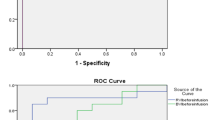Abstract
Purpose
Evaluation of circulating blood volume is important in assessing the status of patients. Although some studies have suggested that ultrasound images of the internal jugular vein (IJV) can be used for the analysis of circulating blood volume, accurate extraction of IJV is necessary to reduce errors. Therefore, this study was designed to develop a new algorithm for dynamic segmentation of IJV and determine appropriate indicators to evaluate the circulating blood volume.
Methods
Our algorithm is based on snake and speckle tracking models. As the region of interest (ROI) of the control points of the snake tracking algorithm was dynamically moved using speckle tracking, ROI size can be decreased leading to a reduction in the tracking error. Some experiments were performed to validate our algorithm. Subsequently, the algorithm was used for the experiment simulating dehydration state among 11 subjects.
Results
Results of the validation experiment suggest that our algorithm showed higher performance for IJV extraction compared with standard methods. Furthermore, it was revealed that some indices such as the average area of IJV were related to the dehydration state of subjects.
Conclusion
This study proposed a new algorithm, which was based on snake and speckle tracking models, for dynamic extraction of IJV in ultrasound images. In addition to algorithm validation, it was suggested that some indices the ultrasound image of IJV could be used for the evaluation of the circulating blood volume.








Similar content being viewed by others
References
Zimmermann M, Feibicke T, Keyl C, Prasser C, Moritz S, Graf BM, Wiesenack C (2010) Accuracy of stroke volume variation compared with pleth variability index to predict fluid responsiveness in mechanically ventilated patients undergoing major surgery. Eur J Anaesthesiol 27(6):555–561
Hofer CK, Senn A, Weibel L, Zollinger A (2008) Assessment of stroke volume variation for prediction of fluid responsiveness using the modified FloTrac (TM) and PiCCOplus (TM) system. Crit Care 12(3):R82
Feissel M, Michard F, Faller JP, Teboul JL (2004) The respiratory variation in inferior vena cava diameter as a guide to fluid therapy. Intensive Care Med 30(9):1834–1837
Lyon M, Blaivas M, Brannam L (2005) Sonographic measurement of the inferior vena cava as a marker of blood loss. Am J Emerg Med 23(1):45–50
Barbier C, Loubieres Y, Schmit C, Hayon J, Ricome JL, Jardin FO, Vieillard-Baron A (2004) Respiratory changes in inferior vena cava diameter are helpful in predicting fluid responsiveness in ventilated septic patients. Intensive Care Med 30(9):1740–1746
Fields JM, Lee PA, Jenq KY, Mark DG, Panebianco NL, Dean AJ (2011) The interrater reliability of inferior vena cava ultrasound by bedside clinician sonographers in emergency department patients. Acad Emerg Med 18(1):98–101
Donahue SP, Wood JP, Patel BM, Quinn JV (2009) Correlation of sonographic measurements of the internal jugular vein with central venous pressure. Am J Emerg Med 27(7):851–855
Bailey JK, McCall J, Smith S, Kagan RJ (2012) Correlation of internal jugular vein/common carotid artery ratio to central venous pressure: a pilot study in pediatric burn patients. J Burn Care Res 33(1):89–92
Baumann UA, Marquis C, Stoupis C, Willenberg TA, Takala J, Jakob SM (2005) Estimation of central venous pressure by ultrasound. Resuscitation 64(2):193–199
Nakamura K, Tomida M, Ando T, Sen K, Inokuchi R, Kobayashi E, Nakajima S, Sakuma I, Yahagi N (2013) Cardiac variation of inferior vena cava: new concept in the evaluation of intravascular blood volume. J Med Ultrason, pp 1–5
Li M, Kambhamettu C, Stone M (2005) Automatic contour tracking in ultrasound images. Clin Linguist Phon 19(6–7):545–554
Yezzi A, Kichenassamy S, Kumar A, Olver P, Tannenbaum A (1997) A geometric snake model for segmentation of medical imagery. IEEE Trans Med Imaging 16(2):199–209
Chen CM, Lu HHS, Lin YC (2000) An early vision-based snake model for ultrasound image segmentation. Ultrasound Med Biol 26(2):273–285
Mikic I, Krucinski S, Thomas JD (1998) Segmentation and tracking in echocardiographic sequences: active contours guided by optical flow estimates. IEEE Trans Med Imaging 17(2):274–284
Duan Q, Angelini ED, Herz SL, Ingrassia CM, Costa KD, Holmes JW, Homma S, Laine AF (2009) Region-based endocardium tracking on real-time three-dimensional ultrasound. Ultrasound Med Biol 35(2):256–265
Helle-Valle T, Crosby J, Edvardsen T, Lyseggen E, Amundsen BH, Smith HJ, Rosen BD, Lima JAC, Torp H, Ihlen H, Smiseth OA (2005) New noninvasive method for assessment of left ventricular rotation: speckle tracking echocardiography. Circulation 112(20):3149–3156
Notomi Y, Lysyansky P, Setser RM, Shiota T, Popovic ZB, Martin-Miklovic MG, Weaver JA, Oryszak SJ, Greenberg NL, White RD, Thomas JD (2005) Measurement of ventricular torsion by two-dimensional ultrasound speckle tracking imaging. J Am Coll Cardiol 45(12):2034–2041
Kass M, Witkin A, Terzopoulos D (1987) Snakes: active contour models. Int J Comput Vis 1(4):321–331
Du Bois D, Du Bois EF (1916) A formula to estimate the approximate surface area if height and weight be known. Arch Intern Med 17(6):863–871
Ishikawa K, Shirato C, Yanagisawa A (1983) Electrocardiographic changes due to sauna bathing. Influence of acute reduction in circulating blood volume on body surface potentials with special reference to the Brody effect. Br Heart J 50(5):469–475
Love AH, Mitchell TG, Phillips RA (1968) Water and sodium absorption in the human intestine. J Physiol 195(1):133–40
Conflict of interest
None.
Author information
Authors and Affiliations
Corresponding author
Rights and permissions
About this article
Cite this article
Qian, K., Ando, T., Nakamura, K. et al. Ultrasound imaging method for internal jugular vein measurement and estimation of circulating blood volume. Int J CARS 9, 231–239 (2014). https://doi.org/10.1007/s11548-013-0921-8
Received:
Accepted:
Published:
Issue Date:
DOI: https://doi.org/10.1007/s11548-013-0921-8




